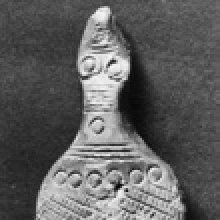Kaushambi, Kauśāmbī, Kauśāmbi: 19 definitions
Introduction:
Kaushambi means something in Buddhism, Pali, Hinduism, Sanskrit, Jainism, Prakrit, the history of ancient India. If you want to know the exact meaning, history, etymology or English translation of this term then check out the descriptions on this page. Add your comment or reference to a book if you want to contribute to this summary article.
Kaushambi has 17 English definitions available.
The Sanskrit terms Kauśāmbī and Kauśāmbi can be transliterated into English as Kausambi or Kaushambi, using the IAST transliteration scheme (?).
Images (photo gallery)
Languages of India and abroad
Sanskrit dictionary
[Deutsch Wörterbuch]
Source: Cologne Digital Sanskrit Dictionaries: Böhtlingk and Roth Grosses Petersburger WörterbuchKauśāmbi (कौशाम्बि):—f. = kauśāmbī [Varāhamihira’s Bṛhajjātaka S. 16, 3.]
Source: Cologne Digital Sanskrit Dictionaries: Sanskrit-Wörterbuch in kürzerer FassungKauśāmbi (कौशाम्बि):—f. = kauśāmba 2).
Sanskrit, also spelled संस्कृतम् (saṃskṛtam), is an ancient language of India commonly seen as the grandmother of the Indo-European language family (even English!). Closely allied with Prakrit and Pali, Sanskrit is more exhaustive in both grammar and terms and has the most extensive collection of literature in the world, greatly surpassing its sister-languages Greek and Latin.
See also (Relevant definitions)
Starts with: Kaushambika, Kaushambipuri, Kaushambiya.
Ends with: Nitkaushambi, Vanakaushambi.
Full-text (+100): Nemicakra, Kaushambiya, Kaushambya, Kaushamba, Vatsapattana, Nitkaushambi, Udayana, Vanakaushambeya, Kosambi, Kaushambeya, Candravatarana, Kusamba, Ghoshilarama, Candamahasena, Kaushambaka, Vanakaushambi, Parapushta, Nagasahvaya, Ghositarama, Nirvaktra.
Relevant text
Search found 43 books and stories containing Kaushambi, Kauśāmbī, Kauśāmbi, Kausambi; (plurals include: Kaushambis, Kauśāmbīs, Kauśāmbis, Kausambis). You can also click to the full overview containing English textual excerpts. Below are direct links for the most relevant articles:
Garga Samhita (English) (by Danavir Goswami)
Verse 5.24.13 < [Chapter 24 - The Killing of the Kola Demon]
Verse 5.24.42 < [Chapter 24 - The Killing of the Kola Demon]
The Matsya Purana (critical study) (by Kushal Kalita)
Part 2.2b - The Paurava Dynasty < [Chapter 3 - Historical aspects in the Matsyapurāṇa]
Part 2.2 - Dynasties of Post-Mahābhārata war (Introduction) < [Chapter 3 - Historical aspects in the Matsyapurāṇa]
Part 2.1a - The Solar Dynasty < [Chapter 3 - Historical aspects in the Matsyapurāṇa]
A Historical Study of Kaushambi (by Nirja Sharma)
Settlement in Early Historic Ganga Plain (by Chirantani Das)
Part 6 - Demography (middle and lower Ganga plain) < [Conclusion]
Part 1 - Position of Sārnāth at the physical and cultural periphery of Vārāṇasī < [Chapter VII - Sārnāth: The Satellite Religious Centre]
Part 5 - Urban centres in South Bihar (a): Aṅga Circle < [Chapter I - The Case Study of Rājagṛha]
Vakyapadiya of Bhartrihari (by K. A. Subramania Iyer)
Verse 3.14.410 < [Book 3 - Pada-kāṇḍa (14): Vṛtti-samuddeśa (On Ccomplex Formation)]
Verse 3.14.256 < [Book 3 - Pada-kāṇḍa (14): Vṛtti-samuddeśa (On Ccomplex Formation)]
Verse 3.14.39 < [Book 3 - Pada-kāṇḍa (14): Vṛtti-samuddeśa (On Ccomplex Formation)]
Annadatri-carita (study) (by Sarannya V.)
8. The South Indian representation in Kurukshetra war < [Chapter 1 - The Myth of Grand Feast]
